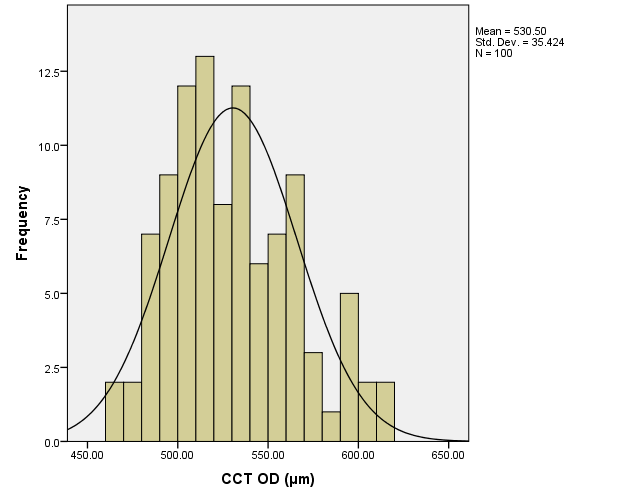Comparison of intraocular pressure and central corneal thickness in non-glaucomatous North- East Indian tribals versus general Indians
Abstract
Purpose: To compare the intraocular pressure (IOP) and central corneal thickness (CCT) of non-glaucomatous North-East (NE) Indian tribals and general Indians.
Materials and methods: In a prospective, cross-sectional study, the IOP and CCT of non-glaucomatous NE Indian tribals (n = 50) and non-glaucomatous general Indians (n = 50) were compared. Glaucoma was ruled out by history, detailed ocular examinations, and investigations.
Results: There was very good correlation between the CCT and IOP values of right and left eyes (p = 0.940 and 0.847, respectively). The difference in the IOP values in the two groups was not statistically significant (p = 0.312 for Oculus Dexter [OD], p = 0.400 for Oculus Sinister [OS]). Similarly, the difference in the CCT values in the two groups was not statistically significant (p = 0.736 for OD and 0.613 for OS). The mean CCT and IOP OD for the whole population was 530.50 ± 35.42 μm and 13.80 ± 2.760 mmHg, respectively. By linear regression analysis, the IOP OD of the whole population had good correlation with CCT OD of the whole population (adjusted r2 = 0.084, p = 0.002), but not with age (adjusted r2=0.000, p=0.314) and sex (adjusted r2 = 0.010, p = 0.163). Similarly, CCT OD for the whole population did not have good correlation with age (adjusted r2 = -0.009, p = 0.762) and sex (adjusted r2 = -0.007, p = 0.603).
Conclusions: In this study of individuals with normal corneas and without glaucoma, no racial variation was found in the CCT and IOP values of the two groups. The IOP OD of whole population had good correlation with CCT, but not with age and sex. There was good correlation between OD and OS values of IOP and CCT.
References
collagen orientation in the human cornea and limbus. Structure 2004;12(2):249-256.
2. Newton RH, Meek KM. Circumcorneal annulus of collagen fibrils in the human limbus. Invest
Ophthalmol Vis Sci 1998;39(7):1125-1134.
3. Hjortdal JØ. Regional elastic performance of the human cornea. J Biomechanics
1996;29(7):931-942.
4. Woo SY, Kobayashi AS, Schlegel WA, et al. Nonlinear material properties of intact cornea and
sclera. Exp Eye Res 1972;14(1):29-39.
5. Luce DA. Determining in vivo biomechanical properties of the cornea with an ocular response
analyzer. J Cataract Refract Surg 2005;31(1):156-162.
6. Kotecha A. What biomechanical properties of the cornea are relevant for the clinician? Surv
Ophthalmol 2007;52(6):109-114.
7. Mansouri K, Leite MT, Weinreb RN, et al. Association between corneal biomechanical properties
and glaucoma severity. Am J Ophthalmol 2012;153(3):419-427.
8. Wells AP, Garway-Heath DF, Poostchi A, et al. Corneal hysteresis but not corneal thickness
correlates with optic nerve surface compliance in glaucoma patients. Invest Ophthalmol Vis Sci
2008;49(8):3262-3268.
9. Congdon NG, Broman AT, Bandeen-Roche K, et al. Central corneal thickness and corneal
hysteresis associated with glaucoma damage. Am J Ophthalmol 2006;141(5):868-875.
10. Kaushik S, Pandav SS, Banger A, et al. Relationship between corneal biomechanical properties,
central corneal thickness and intraocular pressure across the spectrum of glaucoma. Am J
Ophthalmol 2012;153(5):840-849.

Copyright (c) 2019 Asian Journal of Ophthalmology

This work is licensed under a Creative Commons Attribution 4.0 International License.
Authors who publish with this journal agree to the following terms:
- Authors retain copyright and grant the journal right of first publication, with the work twelve (12) months after publication simultaneously licensed under a Creative Commons Attribution License that allows others to share the work with an acknowledgement of the work's authorship and initial publication in this journal.
- Authors are able to enter into separate, additional contractual arrangements for the non-exclusive distribution of the journal's published version of the work (e.g., post it to an institutional repository or publish it in a book), with an acknowledgement of its initial publication in this journal.
- Authors are permitted and encouraged to post their work online (e.g., in institutional repositories or on their website) prior to and during the submission process, as it can lead to productive exchanges, as well as earlier and greater citation of published work (See The Effect of Open Access).


